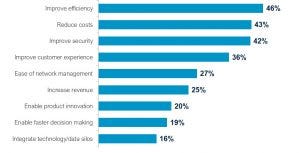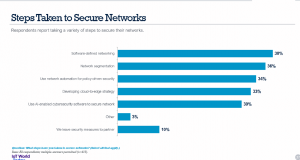IoT Connectivity Spending Climbs as COVID-19 Cases DeclineIoT Connectivity Spending Climbs as COVID-19 Cases Decline
IoT connectivity projects get a green light in 2021, with spending increasing in key areas.
June 8, 2021

IoT connectivity projects get a green light in 2021, with spending increasing in key areas. A majority of respondents (59%) to the IoT World Today Connectivity Survey anticipate an increase in IoT budget.
Respondents see the network as core to project success. Most respondents (57%) anticipate an increased networking budget in 2021 compared with 2020, while just 7% anticipate a decrease.
Respondents are investing in network upgrades to improve efficiency (46%), reduce costs (43%) and improve security (42%).
Respondents report taking a variety of steps to secure networks, including software-defined networking (38%), networking segmentation (36%), and writing policies for network automation (34%).
As COVID-19 cases decline, survey data suggests that spending on IoT projects and network connectivity for IoT will increase as enterprises get back to business at full tilt.
Despite last year’s tumultuous twists and turns, enterprises have seemingly embraced digitization and Internet of Things (IoT) projects as part of their economic recovery plans.
According to the recent IoT World Today Connectivity Survey of 429 respondent, a majority of respondents (59%) anticipate an increased IoT budget in 2021 compared with 2020, while just 6% anticipate a decrease.
The No. 1 primary driver of anticipated increases in 2021 IoT budget is the fact that the pandemic heightened the need for digital initiatives, including for IoT, cited by 44% of respondents who expect an increase.
Further, respondents see the network as core to project success. Most respondents (57%) anticipate an increased networking budget in 2021 compared to 2020, while just 7% anticipate a decrease.
Respondents are investing in network upgrades to improve efficiency (46%), reduce costs (43%) and improve security (42%).

IT Pros Favor 4G, Not 5G, for IoT Connectivity
“Today a range of connectivity technologies are available for enterprises deploying IoT applications. In fact, eight different technologies were chosen by at least 15% of respondents,” said Josh Builta, program director for IoT. Respondents are most likely to have deployed 4G/LTE (53%) to support IoT technologies, followed by Wi-Fi 5 or earlier-generation protocols (42%) and 5G (39%). The survey also indicated a variety of low power wireless technologies, to include LoRa, NB IoT and LTE-M are also seeing uptake in a growing portion of IoT deployments.
”A variety of connectivity technology have and will always be part of IoT, largely because there is no single technology ideal for every application” stated Josh Builta, IoT research director at Omdia.
“That said, we expect low-power technologies that were purpose-built for IoT will see increased adoption in coming years, as will 5G, especially once other elements of that technology’s ecosystem mature.”
How Enterprises Handle IoT Connectivity Challenges
Respondents see connectivity deployments as a hurdle, however, to IoT projects. Some 33% say that connectivity is challenging for IoT, after data security (43%); alongside connectivity, an equal percentage say the lack of staff to manage IoT projects is a hurdle.
Indeed, respondents often need third-party expertise to implement their network upgrades. Among survey respondents planning to upgrade their networks, only 30% are going it entirely alone: 17% have enlisted third parties to conduct upgrades, and some 52% use a combination of third-party services and in-house IT to deploy network upgrades.
Respondents report taking a variety of steps to secure their networks, including software-defined networking (38%), networking segmentation (36%), and writing policies for network automation (34%).
 “IoT technology development is inherently complex.” Builta noted. “Partnering with an system integrator or another third-party can allow IoT developers to relieve at least some of the complexity associated with issues like which connectivity technology or cloud platform to use.”
“IoT technology development is inherently complex.” Builta noted. “Partnering with an system integrator or another third-party can allow IoT developers to relieve at least some of the complexity associated with issues like which connectivity technology or cloud platform to use.”
“Only a small number of organizations have the internal resources to build and develop a robust and secure IoT solution on their own.”
About the Author
You May Also Like
.jpg?width=700&auto=webp&quality=80&disable=upscale)
.jpg?width=700&auto=webp&quality=80&disable=upscale)

.jpg?width=300&auto=webp&quality=80&disable=upscale)


